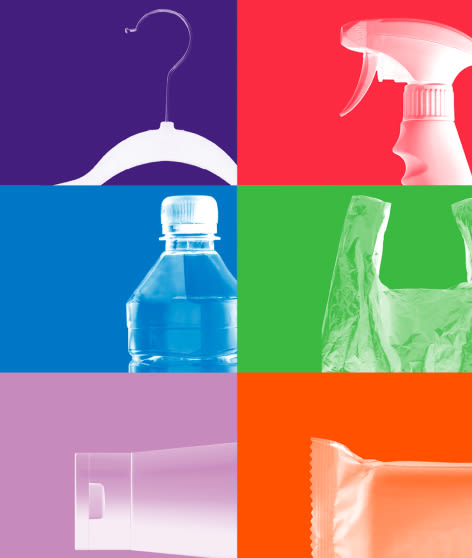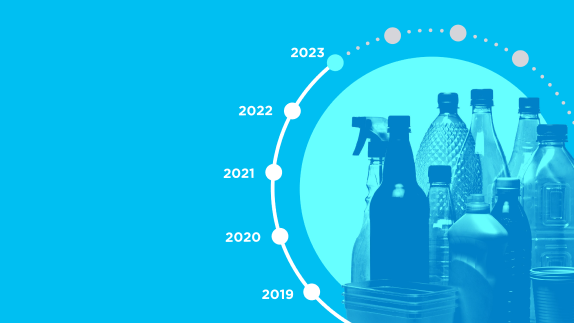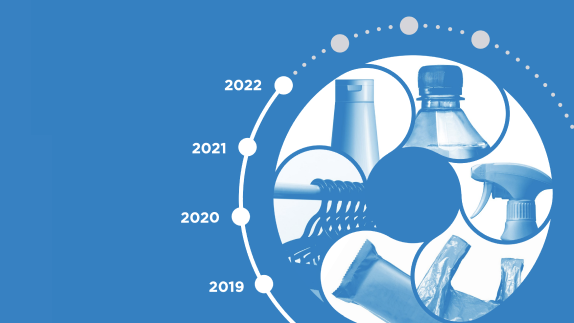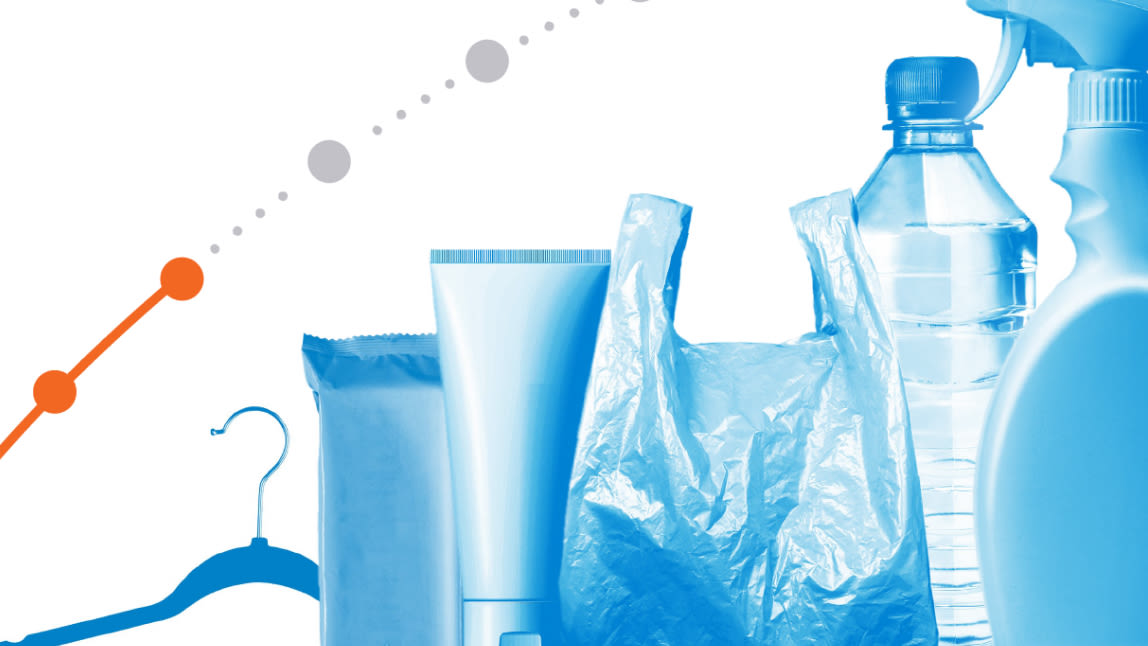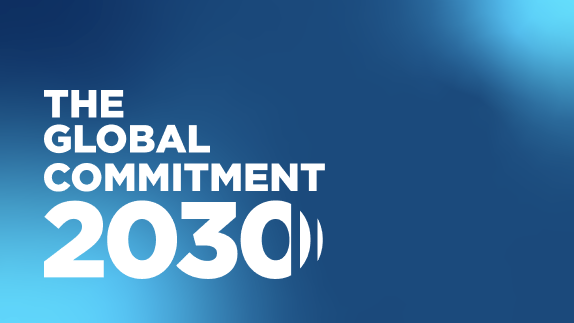Published as part of the Global Commitment Progress Report 2022 by the Ellen MacArthur Foundation and UN Environment Programme
Overall trends
The majority of household and personal product signatories (91%) decreased virgin plastic packaging use between 2020 and 2021. The decrease in virgin plastic packaging averaged nearly 6%, and was predominantly driven by a growth in post-consumer recycled (PCR) content that increased from 11% in 2020 to 14% in 2021. Some signatories, for example those providing cleaning products to institutions, also reported a decrease in their plastic packaging in 2021 resulting from decreased sales after the COVID-19 pandemic. Overall, between 2018 and 2021, the use of virgin plastic packaging decreased by 7% on average.
Many signatories reported expansion of their reuse models, for example refill-on-the-go and refill-at-home for cleaning and personal products. Most signatories (93%) are working on reusereuseThe repeated use of a product or component for its intended purpose without significant modification. pilots or models: from expanding their refill stations across stores and working with innovators such as Algramo to expand their refill offerings, to introducing new product formats such as tablets and powder solutions. However, none of the signatories made progress on increasing their share of reusable plastic packaging, and 45% of signatories do not have any reusable plastic packaging in their portfolio to date.
Actions to accelerate progress
Prioritise reuse using quantitative targets that are embedded at the core of business strategy, with the aim of scaling reuse models and reducing the amount of plastic packaging introduced into the market. Following successful customer-testing of reuse models such as refill stations, signatories should extend beyond pilots to develop strategies that include credible action plans to scale reuse. At the same time, they should target the reduction of the total weight and number of units of plastic packaging introduced into the market. Sector signatories are encouraged to work together to develop a shared reuse infrastructure, with shared learnings with sector companies, innovators, and retailers as a key approach.
Addressing non-recyclable plastic packaging should remain a key priority as it represents a large part of signatories’ portfolio. Businesses are taking actions to better design their packaging for recycling, for example by eliminating PS or PVC from a large portion of their packaging portfolio. However, on average, 45% of signatories’ plastic packaging remains non-recyclable, particularly PP pots, tubs, and trays, and consumer-facing flexible plastic packaging such as pouches and shrink wraps. Innovating away from such packaging, through elimination or reuse solutions, should be prioritised in any packaging strategy.
Reduction targets
Average change in virgin plastic packaging from 2020 to 2021: -5.7%
In 2021, signatories have set 2025 targets to reduce their virgin plastic packaging (i) or total plastic packaging (ii) as part of the mandatory requirements to remain in the Global Commitment.
Trends
In 2021, all household and personal signatories set a virgin reduction target, by 36% on average.
Between 2020 and 2021, the sector reported a decrease in virgin plastic of 5.7%, driven by ten (91%) signatories who increased their PCR content and/or decreased their plastic packaging.
Looking at the overall trend from 2018 to 2021, the sector increased its virgin plastic packaging by an average of 7%.
i. Virgin reduction targets aim to decrease the total weight of virgin plastic in packaging, and should be underpinned by efforts on reuse and elimination in addition to increasing the use of recycled content.
ii. Total reduction targets aim to reduce the total weight of plastic packaging.
For more information about the reduction targets read the 2022 Progress Report.
Elimination of problematic or unnecessary plastic packaging
Trends
Signatories are most commonly targeting multilayer materials, PS, PVC, undetectable carbon black, and pumps/trigger sprays to improve recyclabilityrecyclabilityThe ease with which a material can be recycled in practice and at scale..
However, similar to last year, only 20% of the elimination examples reported by signatories involved fundamental changes to the packaging, products, or business models – including direct elimination of packaging or switching to reuse models – which avoid single-use packaging to begin with. Current efforts include refill solutions for cleaning products and the removal of flexible film formats such as sleeves and stretch wraps.
Highlights
Unilever reported the elimination of unnecessary plastic packaging remains a key part of their aim to reduce virgin plastic packaging usage, predominantly through the introduction of new formats and reuse models. The company has eliminated 40% undetectable carbon black so far, with plans to completely eliminate it by 2025 along with PS, single-use cutlery, and straws.
Werner & Mertz GmbH, The Clorox Company, Reckitt, and The Colgate-Palmolive Company have committed to fully eliminate PS from their packaging portfolio, with The Clorox Company and The Colgate-Palmolive Company additionally committing to completely eliminate PVC.
Moving from single-use towards reuse models
Average reusable plastic packaging in 2021: 1.5% (▼0.1pp vs 2020)
Trends
Following positive customer take-up, the sector reported the introduction or expansion of reuse pilots and models. Most signatories (75%) were focused on ‘refill-at-home’ models, including concentrated solutions to use in refillable bottles, while 33% provided ‘refill-on-the-go’ options including refill stations for laundry detergents, cleaning, and hair products.
In 2021, four signatories had launched more than three reuse pilots (Beiersdorf,Unilever, SC Johnson), and six had planned more than four by 2025. However, none of the signatories increased their overall percentage of reusable plastic packaging in 2021.
Highlights
Unilever is focussed on testing and refining new approaches to accelerate reuse, launching 12 pilots in 2021 and collaborating with Algramo to expand refill-on-the-go pilots in Walmart Chile.
Reckitt launched dishwasher tablets packed in returnable stainless steel packaging, rolled out in 10 Tesco stores in the United Kingdom using Loop. In addition, a powder to liquid solution for Dettol handwash was launched in India, enabling customers to reuse bottle and pump components up to 20 times.
Henkel launched five reuse pilots in 2021, and is planning to launch 23 more by 2025. The company reported that its refill bottles – part of its concept ‘refill bar’ – can be reused five times and cuts plastic usage by 83%.
100% of plastics packaging reusable, recyclable, or compostable (RRC)
Average RRC in 2021: 56% (▲0.3pp vs 2020) || 2025 target: 100%
Trends
In 2021, 55% of household and personal care signatories made no progress on increasing their share of ‘reusable, recyclable, or compostable’ plastic packaging. The five (45%) who did make progress on this metric, did so primarily by better designing their packaging for recycling, including removing coloured pigments, non-recyclable pumps, and switching to tethered and mono-material caps.
On average, 45% of signatories’ plastic packaging remained non-recyclable, including PP pots, tubs, and trays (which make up on average 11% of signatories’ packaging), and consumer-facing flexible plastic packaging (21%) such as pouches and shrink wraps. These non-recyclable formats will need addressing through innovation away from these packaging types wherever possible and scaling recycling infrastructure where relevant.
Highlights
Johnson & Johnson Consumer Health and The Colgate-Palmolive Company have rolled out plastic triggers without metal for bottles across several brands. The Colgate-Palmolive Company has also removed pigments from their PET bottles across five product lines in different markets and moved to recyclable paper for bar soaps in Thailand and the US.
Multiple signatories including Unilever, Reckitt, Johnson & Johnson Consumer Health,and Essity are participating in Holy Grail 2.0 for which the Phase 2, involving semi-industrial scale tests in Copenhagen, proved that the technology was viable for Phase 3 industrial-scale testing. Essity plans to launch eight products in 2022 with digital watermarks in France for Phase 3.
Post-consumer recycled content (PCR) targets
Average PCR in 2021: 14% (2.7 vs 2020) || 2025 target: 31%
Trends
Eight household and personal care signatories (73%) increased their proportion of PCR content, largely driven by increasing recycled content in PET bottles. Two signatories (17%), Unilever and Beiersdorf, increased PCR content by 6 or more percentage points.
Highlights
Unilever increased its PCR content by 6.7 percentage points in 2021, the highest in the sector, to 17.7%. The company reported integrating recycled content across product lines in multiple brands and markets. In North America, Dove has incorporated PCR content into its deodorants, which are also refillable.
Henkel increased its PCR content by 2.3 percentage points to 14.3% in 2021, primarily by incorporating recycled content across its three business units. The company developed a roadmap to meet quantitative milestones to be achieved through approved projects and those in development, including through recycled content via an informal waste collection project.
Household sector compared to other sectors
Endnotes
General note: Some quantitative metrics for 2020 might differ from those reported in the sector insights published in 2021 as some companies updated prior years’ metrics due to improvement in methodology, merger and acquisition or scope expansion.
The change in virgin plastic packaging represents the non-weighted average change reported by all signatories in the sector.
For signatories where data on key metrics was lacking for 2018 on virgin plastic packaging, data was extrapolated based on the metrics’ average for the group.
PS = Polystyrene; PVC = Polyvinyl chloride.
In this document, the quantitative metrics for 2021 and 2025 targets represent the non-weighted average of the data reported by all signatories in the sector. The year-on-year changes reported across all metrics refer to those seen for signatories reporting in both of the last two years (i.e. data from signatories reporting for the first time in 2021 are not included as part of the change).
To be claimed as recyclable/compostable according to the Global Commitment definition of recyclable/compostable ‘in practice and at scale’, packaging needs to meet the thresholds of being recycled/composted at a 30% rate across multiple regions, collectively representing at least 400 million inhabitants. For more information, see ‘How are recyclability and compostability assessed in the Global Commitment?’ in the 2022 Progress Report.
In this document, the quantitative metrics for 2021 and 2025 targets represent the non-weighted average of the data reported by all signatories in the sector. The year-on-year changes reported across all metrics refer to those seen for signatories reporting in both of the last two years (i.e. data from signatories reporting for the first time in 2021 are not included as part of the change).
Ibid.
HDPE = High-density polyethylene; PE = Polyethylene; PET = Polyethylene terephthalate; PP = Polypropylene.
The 2025 target reported is for sector signatories with virgin plastic packaging reduction target, and as such excludes signatories with a total reduction target.
Disclaimer
This report has been produced by the Ellen MacArthur Foundation (the “Foundation”). The Foundation has exercised care and diligence in preparing this report, based on information it believes to be reliable, but makes no representations and gives no warranties, assurances or undertakings (express or implied) in connection with it or any of its content (as to its accuracy, completeness, quality, fitness for any purpose, compliance with law, or otherwise).
The Foundation does not monitor or moderate any external websites or resources linked or referred to in this report. This report does not purport to be comprehensive and none of its contents shall be construed as advice of any kind. Any reliance on it is at reader’s own discretion and risk.
All information on signatories’ progress in these sector insights has been provided by the relevant signatories and has not been audited or verified by the Foundation or UN Environment Programme (UNEP). Each signatory is responsible for the information it submitted.
The Foundation and UNEP do not warrant that all information submitted by individual signatories is contained or represented in this report and, without limiting the generality of the foregoing, the Foundation may: (i) have excluded data which it believes to be inaccurate; (ii) have excluded from year-on-year calculations data from signatories which have not reported data in both years; and (iii) have normalised information to produce the aggregated and averaged statistics featured in this report. Further, if a signatory has not reported by the relevant deadline(s), its data will not be included in this report. If you are a signatory and you believe there has been an error in the reproduction of the information provided to us by your organisation, please contact us as soon as possible at reportingGC@ellenmacarthurfoundation.org, or your contact at UNEP.
To the maximum extent permitted by any applicable law, the Foundation, each entity within its group and each of its associated charities and their respective employees, workers, officers, agents and representatives disclaim in full all liability for any loss or damage of any kind (whether direct or indirect and whether under contract, tort, breach of statutory duty or otherwise) arising under or in connection with this report or any of its contents.
Contributions to this report by any third party do not indicate any partnership or agency relationship between that contributor and the Foundation, nor the endorsement by the Foundation of that contributor or the endorsement by that contributor of this report’s conclusions and recommendations.
The Foundation is not a supplier of, or otherwise affiliated with, and does not recommend or endorse, any third party or the products or services referred to in this report.
About these sector insights
This document presents insights and data on the progress made by household and personal care signatories listed below to achieve their commitments on plastic packaging. This document is part of the 2022 Global Commitment Progress Report.
About the Global Commitment
The Global Commitment is an initiative led by the Ellen MacArthur Foundation, in collaboration with the UN Environment Programme. Through the Global Commitment, businesses and governments commit to change how we produce, use, and reuse plastic. They will work to eliminate the plastic items we don’t need; innovate so all plastic we do need is designed to be safely reused, recycled, or composted; and circulate everything we use to keep it in the economy and out of the environment. Learn more
Global Commitment signatories reporting in this sector
Beiersdorf AG Consumer Business
Colgate-Palmolive Company
Essity AB
Freudenberg Home and Cleaning Solutions GmbH
Helen of Troy Limited*
Henkel AG & Co. KGaA
Johnson & Johnson Consumer Health
Reckitt
SC Johnson
The Clorox Company
Unilever
Werner & Mertz GmbH
*This signatory did not provide data for one or more metrics for 2021 and so is excluded from year-on-year comparisons and the 2021 average for the relevant metric(s).



